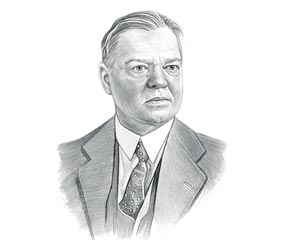|
|
|
|
|
The economic boom in the 1920s led to high consumerism, easy credit schemes and increased debt. The prolonged period of of rising stock prices was called the Long Bull Market during which time stock brokers encouraged speculation with the practice of buying stocks "on margin" (buying stocks with loaned money). The economy began to contract and professional investors started selling their stocks and share prices began to slowly fall. Stockbrokers began to make large-scale margin calls, demanding that investors repaid their loans all at once. Panic started, smaller investors, worried about paying off their loans, began to sell and stock prices fell even further. The stock market went into free fall and on Tuesday, October 29, 1929 (nicknamed Black Tuesday) stock prices completely collapsed. Between $10-$15 billion was lost in just one day due to the plummeting share prices and the 1929 Wall Street Crash. What was the 1929 Wall Street Crash? The Wall Street Crash was the collapse of U.S. Stock Market due to the panic-selling of massive amounts of stocks and shares. Between $10-$15 billion was lost in the Wall Street Crash in just one day. When was the Wall Street Crash? The Wall Street Crash happened on October 29, 1929 (Black Tuesday) What caused the Wall Street Crash? The Wall Street Crash was caused by a variety of different factors including the US Economic Boom, over-confidence, consumerism, overproduction, easy credit, the Stock Market boom and the 'Long Bull Market'. What were the Effects of the Wall Street Crash? The impact and effects of the Wall Street Crash resulted in the closure of banks, bankruptcies, suicides, evictions, mass unemployment and wage cuts that led to the Great Depression. For comprehensive facts and information refer to the Causes and Effects of the Wall Street Crash Facts about
Wall Street Crash America was enjoying an economic boom, a period of growth and prosperity. Industries and businesses boomed and people began investing in the stock market attracted by the potential of massive profits. Wall Street had prospered from the 'Long Bull Market' in which stock prices rocketed from an average of $50 per share in 1922 climbing to an enormous $350 per share in 1929. The Long Bull Market saw more investors wishing to buy stocks than were willing to sell, which led to the continuing rise in share prices as investors competed to obtain available equity. New investors, eager to get a share in the market, bid the prices of stock up. Stock prices had began to rise sharply in 1926 and 1927, but the high point for the 1929 market prices was August 1929. American were 'Buying on Margin' to acquire their stocks - which effectively meant buying stocks with loaned money. By 1929 between 3 to 4 million Americans (about 10% of US households) had invested in the stock market. On March 25, 1929 there was a mini-crash on Wall Street. Banker Charles Mitchell managed to stop the marketís slide on this occasion but the 'writing was on the wall'. Most ignored the warning. During 1929 steel production was declining, construction was decreasing, automobile sales were down, and consumers were building up high debts because of easy credit. Despite the serious problems the stock market continued its upward momentum, heedless of real economic indicators, and stocks hit record levels month after month and the Dow Jones index had more than doubled since its low point in March 1929. The Bull Market could only last as long as investors were putting new money into it. By the summer of 1929 the Wall Street stock market was running out of new investors. On 5th September, 1929 investor and business theorist Roger Babson made a speech at the Annual Business Conference in Massachusetts predicting that 'Sooner or later, a crash is coming, and it may be terrific'. By September 1929 professional investors realized that the economy was dramatically decreasing and were aware of the dangers of the 'Boom and Bust' cycle. They began to sell off their stocks. Share prices began to slowly fall and more investors, worried about their ability to pay off their loans, also started to sell. The downward spiral had begun and and stock prices fell further. On Monday, October 21, 1929 stock brokers began to make large-scale 'margin calls' demanding immediate repayment of loans from their clients. The Panic on Wall Street started to set in. The panic started to spread and within four days, on October 24, 1929 (Black Thursday), a record 12,894,650 shares were traded on the Wall Street Stock Market. On Friday October 25, 1929 Leading bankers and investors frantically attempted to stabilize the market by buying up blocks of stock that resulted in a moderate rally. On Monday, October 28, 1929 the stock market went into free fall and losses as high as $5 billion were reported. The contagion spread to the stock markets in Europe. On Tuesday, October 29, 1929 (Black Tuesday) stock prices completely collapsed. Margin buyers were forced to sell and there was panic-selling of all stocks. A massive 16,410,030 shares were traded on the New York Stock Exchange in a single day. Between $10-$15 billion was lost on Black Tuesday due to the plummeting share prices. Millions of Americans lost their life savings Share prices continued to drop and by mid-November a staggering $30 billion had been lost on the stock market. On November 23, 1929 the stock market hit rock bottom and then at last began to stabilize. The 1929 Wall Street was finally over. It took 23 years for the US market to recover. |
| US American History |
| 1929-1945: Depression & WW2 |
|
|
|
|
|
First Published2016-04-19 | |||
|
Updated 2018-01-01 |
Publisher
Siteseen Limited
| ||
|
|

